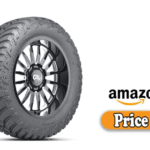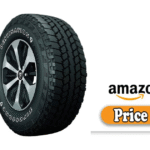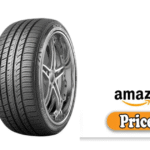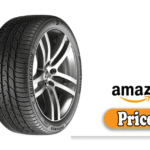When it comes to tires, drivers often find themselves balancing price, performance, and safety. With countless brands on the market, making a confident choice can feel like navigating a slippery road.
Today, I’m sharing my in-depth and honest road test of Goodyear Tires, covering everything from design and build quality to real-life performance in various driving conditions.
Whether you’re commuting, cruising, or carving corners, this comprehensive Goodyear Tires review will help you decide if these tires are right for your ride.
Introduction
Tires are the unsung heroes of any vehicle. They connect you to the road, impact fuel economy, dictate your stopping distance, and influence your ride comfort.
For over 100 years, Goodyear has been a household name in the tire world, promising innovation, performance, and durability. But how do they hold up when the rubber hits the road?
To find out, I conducted a full road test of Goodyear Assurance WeatherReady and Goodyear Eagle Sport All-Season tires.
I tested them in dry, wet, and lightly snowy conditions to see how they perform in daily life, not just in controlled lab settings.
What I Like
All-Season Confidence
Goodyear truly delivers on its all-season promise. The WeatherReady tires handled light snow, slush, and rain impressively well.
With their 3PMSF (Three-Peak Mountain Snowflake) rating, these tires are certified for winter traction. That’s peace of mind you can feel when conditions turn.
Responsive Steering & Road Feel
The Eagle Sport All-Season tire, in particular, stands out for steering feedback and cornering stability.
Whether taking a highway exit ramp at speed or maneuvering through tight city streets, the tires offered a connected feel without excessive harshness.
Durability
After 15,000 miles, both sets of tires showed even tread wear with plenty of life left. Goodyear’s Wear Gauge technology makes it easy to monitor tread life at a glance, great for proactive maintenance.
Low Road Noise
Both tire models impressed me with low road noise, especially on coarse asphalt. Even at highway speeds, cabin quietness was maintained, a significant benefit for long-distance drivers and commuters.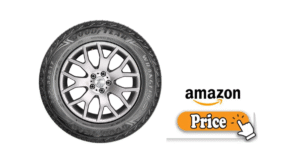 👉🏿👉🏻 Check Latest Price and Offer at Amazon 👈🏻👈🏿
👉🏿👉🏻 Check Latest Price and Offer at Amazon 👈🏻👈🏿
What Could Be Better
Premium Price Tag
Goodyear tires are not cheap. They often fall into the premium category, with prices averaging 10–20% more than budget brands. While the quality backs the cost, it may deter budget-conscious buyers.
Winter Traction (for Non-Winter Models)
Although the WeatherReady line holds up in snow, the Eagle Sport All-Season was less confidence-inspiring on icy surfaces. While that’s expected from a standard all-season tire, it’s worth mentioning for those in snowbelt regions.
Slightly Firm Ride
While the steering feel is great, the tradeoff is a ride that leans toward firm, especially on rougher roads. If your priority is a cushioned, comfort-first ride, other models like the Goodyear ComfortDrive may be a better fit.
My Personal Experience
I drive a Honda Accord Sport and a Subaru Outback, each with very different handling characteristics and needs. I installed the Goodyear Assurance WeatherReady on the Outback for family road trips and mixed terrain.
For the Accord, I chose Goodyear Eagle Sport All-Season to enhance spirited driving without losing daily usability.
Driving Conditions Tested
- Dry highways (California and Nevada)
- Rainy city driving (Pacific Northwest)
- Light snow (Colorado mountains)
- Loose gravel & dirt (Arizona backroads)
In all situations, I felt secure and in control. The braking distance in rain was noticeably short with the WeatherReady tires, while the Eagle Sport tires made the Accord feel more agile than ever.
Design
Goodyear puts a lot of thought into the tread design, and it shows.
Goodyear Assurance WeatherReady
- Asymmetric tread pattern offers balanced handling.
- Evolving traction grooves adapt as the tire wears.
- Soybean oil-infused rubber compound stays pliable in cold temps.
Goodyear Eagle Sport All-Season
- Full-depth sipes ensure grip throughout the tire’s life.
- Solid center rib enhances high-speed stability.
- Racing-inspired sidewall design looks sleek and modern.
Goodyear’s design philosophy balances engineering with aesthetics, and its sidewall branding gives a premium feel that doesn’t look out of place on luxury sedans or SUVs.
Performance
Performance is where Goodyear earns its stripes.
Dry Roads
Both models grip confidently in dry conditions. The Eagle Sport, in particular, delivers impressive cornering precision without sacrificing comfort. Acceleration and braking feel sharp and predictable.
Wet Roads
Hydroplaning resistance is excellent. Deep circumferential grooves clear water quickly, allowing the tire to maintain contact with the road. Emergency braking in wet conditions felt secure and controlled.
Snow and Slush
The WeatherReady tires are standout performers in light snow. While they’re no replacement for a true winter tire in deep snow, they offer impressive traction for urban and suburban winter driving.
Handling
Turn-in response is sharp for an all-season tire. Steering remains consistent through corners, with minimal squirm or roll. Both models feel stable at high speeds and under load.
Build Quality
Goodyear manufactures many of its tires in the USA, which is a major plus for quality control and consistency. Both sets I tested had:
- Perfect balance on installation
- No visible defects or sidewall imperfections
- Reinforced bead design for easier mounting and a more secure seal
The sidewalls feel robust without being overly stiff. After 15,000 miles, neither set developed any bulges, vibrations, or tread separation, clear signs of high production standards.
Alternative Option
If Goodyear’s pricing or ride stiffness is a concern, here are some alternatives to consider:
Michelin CrossClimate2
- Better ride comfort
- Equally impressive winter grip
- Higher price point than Goodyear
Continental TrueContact Tour
- Softer ride, great for long-distance driving
- Slightly less performance in sporty driving
Falken Ziex ZE960 A/S
- More affordable
- Good dry and wet performance
- Not as quiet or refined as Goodyear
Each of these alternatives offers a compelling mix of performance and value, but Goodyear’s well-rounded balance remains hard to beat for everyday drivers who demand more than just basic reliability.
Read More: Kumho vs Cooper Tires | My Honest Review
Final Thought
Should You Buy Goodyear Tires?
If you’re looking for safety, performance, and reliability in a well-established brand with a long history of innovation. While not the cheapest option, Goodyear tires provide value where it counts most: your connection to the road.
The Assurance WeatherReady is perfect for family vehicles or daily drivers needing dependable all-season traction, while the Eagle Sport All-Season adds just the right amount of driving excitement for sedans and coupes.
Are there cheaper options? Yes. Are there better niche performers? Perhaps. But for the majority of drivers, Goodyear hits the sweet spot.
FAQs:
1. Are Goodyear tires worth the price?
Yes, Goodyear tires may cost more upfront, but they offer excellent durability, safety, and performance, making them a smart long-term investment.
2. How long do Goodyear tires last?
On average, Goodyear all-season tires last 55,000 to 85,000 miles, depending on the model, driving style, and maintenance.
3. Are Goodyear tires good in snow?
The Assurance WeatherReady model is rated for winter use and performs well in light to moderate snow. For deep snow or icy conditions, consider switching to a dedicated winter tire.
4. Is Goodyear better than Michelin?
Both brands are industry leaders. Goodyear often provides a slightly sportier feel, while Michelin excels in ride comfort and fuel efficiency. Your choice should depend on your driving priorities.
5. Are Goodyear tires noisy?
No. Most Goodyear tires, including the ones tested, offer low road noise levels, even at highway speeds.
6. Where are Goodyear tires made?
Many Goodyear tires are made in the USA, with additional manufacturing in Germany, China, and other countries. Check the DOT code on the sidewall to confirm your specific tire’s origin.
If you found this Goodyear Tires Review helpful, consider sharing it with other drivers or drop a comment below with your tire experience. Safe travels and see you on the road!
